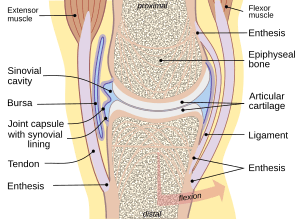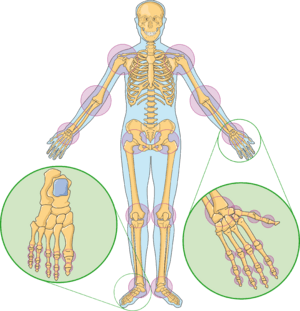Joint facts for kids
A joint is the place where two or more bones make contact. They allow movement (except for skull bones) and give mechanical support.
Joints have cartilage in between them, which help to make the movement flexible. Joints are described structurally and functionally. Structural classification is how the bones connect to each other; function is the degree of movement between the articulating bones.
Biomechanical classification
Joints can also be classified based on their anatomy or on their biomechanical properties. According to the anatomic classification, joints are subdivided into simple and compound, depending on the number of bones involved, and into complex and combination joints:
- Simple joint: two articulation surfaces (e.g. shoulder joint, hip joint)
- Compound joint: three or more articulation surfaces (e.g. radiocarpal joint)
- Complex joint: two or more articulation surfaces and an articular disc or meniscus (e.g. knee joint)
Anatomical
The joints may be classified anatomically into the following groups:
- Joints of hand
- Elbow joints
- Wrist joints
- Axillary articulations
- Sternoclavicular joints
- Vertebral articulations
- Temporomandibular joints
- Sacroiliac joints
- Hip joints
- Knee joints
- Articulations of foot
Humans have also developed lighter, more fragile joint bones over time due to the decrease in physical activity compared to thousands of years ago.
Images for kids
See also
 In Spanish: Articulación (anatomía) para niños
In Spanish: Articulación (anatomía) para niños




